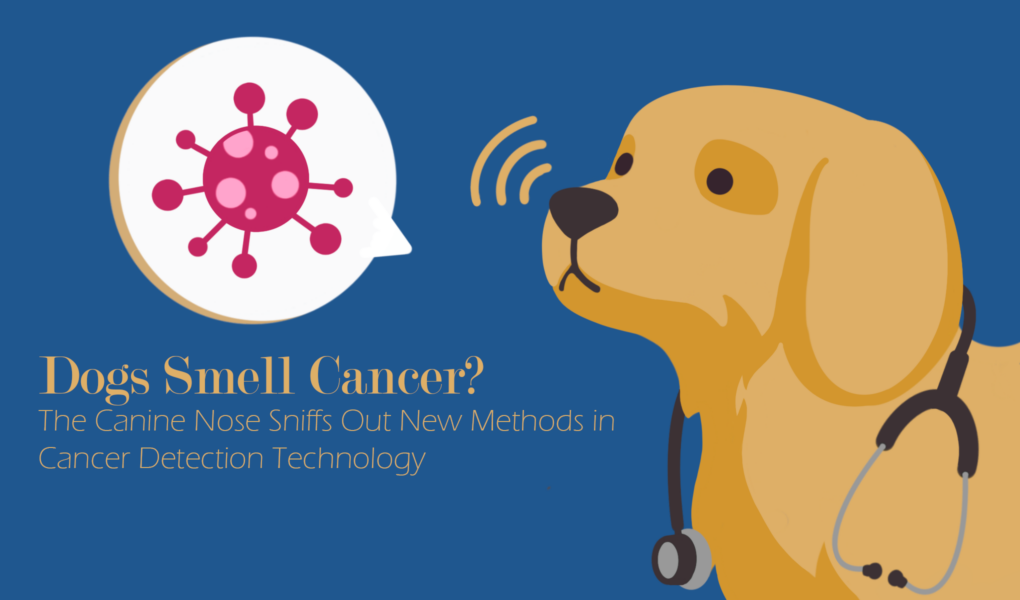Abstract
What happens when man’s best friend meets man’s worst enemy? Engineering efforts into canine scent detection have laid the groundwork for emerging disease diagnostic tools. A dog’s nose can sniff out cancerous organic compounds within a person. Olfactory screenings have revealed developments in cancer characterization that directly affect novel therapeutic approaches. The evolution of these mechanisms will dramatically alter early cancer detection methods.
Keywords: cancer, detection, olfactory screening, diagnostics, disease intervention, biomedical technology
Get a Whiff of This…
The second major cause of mortality worldwide, cancer, accounts for one in every six deaths. The American Cancer Society predicts that the future global cancer burden is likely to escalate exponentially, and sources say that cancer incidents could rise by over 10 million cases by 2040 [1]. Early detection methods are the most effective way to mitigate the risks associated with cancer [2]. Despite many strides in the fight against cancer, intervention is still inadequate, leaving many early forms of cancer undetected. In the early stages, lung cancer often goes undetected despite being one of the most frequently diagnosed tumors with some of the highest mortality rates [3]. Biomedical engineers are strategizing potential avenues using canines within fields of early diagnostic cancer screening processes to solve current detection issues before disease onset [1].

Figure 1. The pervasive proliferation and transformation of healthy cells characterize cancer.
The above slide depicts the movement of cancer (shown in green), disrupting the inherent cellular framework and changing healthy environments [4].
Putting Cancer on A Leash
Efficiency, accuracy, reliability, and accessibility are key factors in engineering diagnostic techniques. Current methods of cancer diagnosis include 2D and 3D tumor imaging, X-ray imaging, tomography, and genomic analysis of cells [5]. Deficits in effectiveness and cost efficiency generate a need for improvement among various cancer evaluation modalities. However, the introduction of dogs to detection offers an inexpensive and effective methodology, contrary to predominant techniques. The challenges faced by the biomedical field have prompted the development of new, novel approaches that enhance the precision of the detection process. Integrating new ideas and innovations can enable refining technologies to be optimally efficient across various clinical niches. As cancer can exist in over 200 forms, techniques to combat it must be as ever-evolving as the disease itself [6].
Biomedical scent detection dogs are a recent innovation within the medical world. Researchers train extraordinary canine olfactory senses to detect odors specific to medical conditions or diseases, creating a detection method that is both safe and cost-effective [7]. For example, scientists tested the capacity of canine olfactory sensory detection while screening COVID-19 cases. Dogs trained to detect SARS-CoV-2-associated odors were successful in sniffing out infected cases from sampled bodily fluids [8]. Due to the resulting levels of specificity and sensitivity in early-stage detection, the potential applications beyond COVID-19 are promising.

Figure 2. Upon the success of medical detection dogs, widespread adoption of these screening techniques and related pilot study implementation occurred [9].
First lines of biomedical detection dog research initiatives targeted patients with diabetes, malaria, bacterial infection, and more. Such studies proved the dog’s ability to decipher between healthy and diseased patient samples [10]. One such exploration proved the accuracy of canine scent detection of bacterial pathogens, such as Escherichia coli, and found detection sensitivity to be close to 100% and specificity greater than 90% [11]. In its infancy, as these examples show, this ingeniously crafted detection system has demonstrated operational viability across diverse studies thanks to its promising non-invasive design, responsiveness, and large-scale applicability.
Canine Noses and Cancer Diagnoses

Figure 3. Canines have a much more extensive collection of olfactory receptors than humans [12].
As a dog possesses exemplary memory, olfactory senses can be conditioned and harnessed as biomedical detectors. Metabolic changes within one’s volatile organic compounds (VOCs) typically generate disease-specific odors. Each individual’s natural VOC emittance depends on their background, lifestyle, and other factors. Certain VOCs can indicate disease onset, condition, or location. Biomedical engineering analyses categorized the “human volatilome” and identified variations in cancer-specific VOCs [13]. Diseases that display specific VOC patterns include several types of cancer, asthma, diabetes, heart disease, and more [10]. As olfactory biomarkers, disease-specific VOCs can be the key to diagnosing bacterial, infectious, and metabolic diseases [14].
So, what happens when man’s best friend meets man’s worst enemy? First answered in 1989, a woman became aware of an abnormal lesion due to her dog incessantly smelling it while the dog paid no attention to any other lesions on her body. The dog would even sniff the growth through its owner’s clothing. Growingly concerned, the woman decided to have the site examined when her dog attempted to bite off the lesion. Upon examination, scientists diagnosed the lesion as a malignant melanoma tumor. Had the tumor not been discovered at a curable stage, amalgamating cell transformation would have catalyzed cancer development. This dog’s intervention saved its owner’s life [15]. You probably already knew that dogs have an inherently keen sense of smell. The olfactory test exhibited the natural ability of dogs to distinguish healthy samples from cancerous samples using only their noses [14].
Scientists are investigating cancer-specific VOCs as potential indicators of specific diseases, introducing a more individualized diagnostic protocol to the biomedical scene. One early study trained a dog to recognize the urine scent from prostate cancer patients. After correctly identifying 30/33 cancer cases from samples, one patient “wrongly” identified with cancer was reexamined and diagnosed with prostate cancer shortly after [16]. See the figure below for further elaboration on such foundational studies.

Figure 4. Various early studies evaluated the ability of household dogs to detect cancer from samples based on sensitivity and specificity [7, 14-18].
Detection by way of animals with acute sensory modalities seemed promising. The field has unleashed trials of sniffer dogs into the realm of diagnostics. According to studies, professionals train dogs to sit down when they detect a scent indicative of cancer. Engineering methodologies can amplify the potential for reliability and effectiveness in detection processes that use cancer-sniffing dogs. To ensure efficiency and accuracy, engineers must design standardized modalities.
Sending Cancer to the Pound
Estimates indicate that accompanying screening tests are lacking for 57% of diagnosed cancers. Shockingly, research reveals that recommended screening tests detect only 1 in 7 potentially diagnosable cancers. Modern science has allowed improvements in cancer diagnostics, but they are not enough. Frighteningly, only 3% of lung cancers are detected using approved screening methods [19].
Medical scent detection dogs could be a whiff of hope for cancer intervention. Positive reinforcement conditioning specific to cancer type is the unanimous factor among olfactory screening. Dogs and their observed responses have the potential to revolutionize specialized early detection. When challenged with 30 lung cancer-positive breath samples and 120 healthy samples, trained dogs could distinguish the samples with 97% validity [20]. Expanding research into olfactory mechanisms and scent indicators could reveal the potential to engineer specific biomarkers, another step in individualizing and irradicating cancer.
Barking Up the Right Tree?
The applications of cancer-sniffing canine technologies are beyond monumental. Comparatively high expressions of specificity, meaning accurate detection, and sensitivity, meaning applicable to various target forms, make this tool particularly advantageous. In addition to current diagnostic modalities, canine olfactory screening can go hand in hand with alternative detection via molecular means. For example, in cases of disease, olfactory examinations can be a precursor to more cost-intensive tests, such as PCR, that require time and laboratory examination. Amazingly, it only takes one dog to quickly perform a mass population screening, so environments in particular need (hospitals, nursing homes, universities, and more) can be sniffed out for potential disease threats [8].
Even opposition to these studies helps us learn about the canine responses elicited in reaction to disease detection. Some clinicians have challenged olfactory screening methods, claiming that dogs respond to odors associated with disease symptoms rather than cancer. In this case, dogs would smell the scent of VOCs indirectly related to cancer, such as inflammation or metabolic transformation [14]. Not only does this substantiate canine scent abilities, but it also means that an even more vast array of disease types can be targeted by this methodology, with implications stretching to heart disease and viral pathogens.

Figure 5. Potentially beneficial for surveillance, detection of early stages of necrosis or transformation can indicate early neoplastic pathway development toward chronic disease or cancer [21].
Inspired by canine medical detectors, scientists are working to create specialized synthetic olfactory tests. The electronic nose, for example, uses gas sensor arrays to identify VOCs emitted by lesions [22]. Electronic nose technology mimics the smelling senses of a dog and actively identifies volatile odorous samples. Synthetic bio-inspired olfactory tests maximize accuracy, replicability, and translation in cancer detection. Proving specific VOC signatures per cancer type, nanotechnology is another emerging method engineered to discriminate odors like canine noses. A nanosensor array could differentiate between cancerous and healthy samples in one study. With the capacity to determine patterns in different cancer types, this canine-influenced tool could account for deficiencies of specific information in current cancer diagnostic practices [23]. Completely changing the game of biomarker characterization, machine-based olfactory methods have the power to integrate and interpret VOC profiling fully.
Paws for a Cause
Olfactory screening has the potential to change the landscape of the medical industry completely. Screening tools are integral to cancer prevention, characterization, and treatment. Low accessibility and high costs plague the current medical climate [5]. Marginalized populations inherently have limited access to diagnostic tools and are, as a result, disproportionately vulnerable to cancer. Driving the need for low-cost diagnostic tools, early-stage “windows” of cancer development are often undiagnosed, and eventual treatment calls for more expensive measures [24]. Not only are they budget-burdening, but these procedures can be invasive and high-risk. Cancer diagnostic methods should ideally be budget-friendly, noninvasive, accurate, and accessible [13].

Figure 6. Canine diagnostic technology exemplifies desirable factors of detection methods: It is cost-and-time efficient, noninvasive, and promising for early intervention [9].
Dogs can “sniff out” specific diseases, distinguish metastases, and monitor therapeutic successes [22]. Engineering methods within olfactory techniques have the potential to significantly alleviate the monetary burdens of treatment and incidence within marginalized populations [12]. While some limitations hinder the full prediction, diagnosis, and treatment of cancer, canine technologies are unveiling new opportunities at the forefront of cancer diagnostics. Although this is a newly developed technology, widespread screening using medical detection dogs has the opportunity to catalyze significant effects on cancer surveillance, recurrence, and mortality. Combined with engineering abilities, Olfactory screening tools can revolutionize medicine’s future by “sniffing out” new diagnostic measures one whiff at a time.
Links for Further Reading:
- COVID-19:
https://cdn.who.int/media/docs/default-source/blue-print/who-consultation-screening-dog s–8th-march-2021.pdf?sfvrsn=a0d8cbda_1&download=true ● Prostate Cancer: https://www.ncbi.nlm.nih.gov/pmc/articles/PMC4643706/ ● Colorectal Cancer:
https://www.ncbi.nlm.nih.gov/pmc/articles/PMC8375464/
Watch More:
- BBC Earth:
https://www.youtube.com/watch?v=e0UK6kkS0_M ● NewScientist:
https://www.youtube.com/watch?v=Xo4vDVbkSAE ● Guinness World Records:
https://www.youtube.com/watch?v=UxuqGDC_2pE
References
- “Global Cancer Facts and Figures 4th Edition.” American Cancer Society.
https://www.cancer.org/content/dam/cancer-org/research/cancer-facts-and-statistics/global-cancer -facts-and-figures/global-cancer-facts-and-figures-4th-edition.pdf (accessed: Sep.2023).
- “Promoting cancer early diagnosis.” World Health Organization. https://www.who.int/activities/promoting-cancer-early-diagnosis (accessed: Sep.2023).
- P. Riedlova. “Olfactometric diagnosis of lung cancer by canine scent – A double-blinded study.” ScienceDirect.
https://www-sciencedirect-com.libproxy1.usc.edu/science/article/pii/S0965229922000024 (accessed: Sep.2023).
- “Cancer cell movement,” umnCSE, Youtube, https://www.youtube.com/shorts/ea6-DYf_MWo [Sep. 2023].
- A. Pulumati. “Technological advancements in cancer diagnostics: Improvements ..” National Library of Medicine. https://www.ncbi.nlm.nih.gov/pmc/articles/PMC9940009/ (accessed: Sep.2023).
- “Types of cancer,” Cancer Research UK, https://www.cancerresearchuk.org/what-is-cancer/how-cancer-starts/types-of-cancer#:~:text=The re%20are%20more%20than%20200,There%20are%205%20main%20groups. (accessed Sep. 2023).
- C. Reeve and M. Koivusalo, “Biomedical scent detection dogs: Would they pass as a health technology?” Pet Behaviour Science, https://journals.uco.es/index.php/pet/article/view/10785. (accessed Sep. 2023).
- W. Karesh, “Consultation on the use of trained dogs for screening COVID-19 cases,” World Health Organization, https://cdn.who.int/media/docs/default-source/blue-print/who-consultation-screening-dogs–8thmarch-2021.pdf?sfvrsn=a0d8cbda_1&download=true. (accessed Sep. 2023).
- “How Can These Dogs Smell Disease?” Guinness World Records, Youtube, https://www.youtube.com/watch?v=UxuqGDC_2pE [September 2023].
- P. Jendrny, Canine olfactory detection and its relevance to medical detection, https://www.ncbi.nlm.nih.gov/pmc/articles/PMC8375464/, (accessed Sep. 2023).
- M. Maurer, “Detection of bacteriuria by canine olfaction,” NIH National Library of Medicine, https://pubmed.ncbi.nlm.nih.gov/27186578/, (accessed Sep. 2023).
- E. F. Andrews, R. Pascalau, A. Horowitz, G. M. Lawrence, and P. J. Johnson, “Extensive connections of the canine olfactory pathway revealed by tractography and Dissection,” Journal of Neuroscience, https://www.jneurosci.org/content/42/33/6392, (accessed Sep. 2023).
- F. Pirrone, “Olfactory detection of cancer by trained Sniffer Dogs: A systematic review of the literature,” Journal of Veterinary Behavior, https://www.sciencedirect.com/science/article/abs/pii/S1558787817300539?via%3Dihub, (accessed Sep. 2023).
- M. Shirasu, “The scent of disease: volatile organic compounds of the human body related to disease and disorder,” Oxford Academic, https://academic.oup.com/jb/article/150/3/257/867730?login=true, (accessed Sep. 2023).
- H. Williams and A. Pembroke, “Sniffer Dogs in the Melanoma Clinic,” ScienceDirect, The Lancet, https://www.thelancet.com/journals/lancet/article/PIIS0140-6736(01)06065-2/fulltext (accessed Sep. 2023).
- J. Cornu, “Olfactory detection of prostate cancer by dogs sniffing urine: A step forward in early diagnosis,” NIH U.S. National Library of Medicine, NIH, https://www.ncbi.nlm.nih.gov/pmc/articles/PMC4643706/ (accessed Sep. 2023).
- H. Sonoda, “Colorectal cancer screening with odour material by canine scent detection,” NIH U.S. National Library of Medicine, NIH, https://www.ncbi.nlm.nih.gov/pmc/articles/PMC8375464/ (accessed Sep. 2023).
- M. McCulloch, “Diagnostic accuracy of canine scent detection in early- and late-stage lung and breast cancers,” NIH National Library of Medicine, https://pubmed.ncbi.nlm.nih.gov/16484712/ (accessed Sep. 2023).
- E. Young, “New Research Highlights Just One In Seven Diagnosed Cancers Found By A Recommended Screening Test,” NORC.
https://www.norc.org/research/library/new-research-highlights-just-one-in-seven-diagnosed-canc ers-foun.html#:~:text=According%20to%20new%20research%20from,pursuant%20to%20other %20medical%20care. (accessed Sep. 2023).
- “Can dogs sniff out lung cancer?” American Lung Association, https://www.lung.org/blog/can-dogs-sniff-out-lung-cancer#:~:text=Amazingly%2C%20the%20d ogs%20were%20able,said%20in%20a%20press%20release (accessed Sep. 2023).
- “Dogs Can Smell Cancer,” BBC Earth, Youtube, https://www.youtube.com/watch?v=e0UK6kkS0_M [September 2023]. [22] A. D’Amico, “Identification of melanoma with a gas sensor array,” Wiley Online Library, https://onlinelibrary.wiley.com/doi/abs/10.1111/j.1600-0846.2007.00284.x (accessed Sep. 2023).
- G. Peng, “Detection of lung, breast, colorectal, and prostate cancers from exhaled breath using a single array of nanosensors,” British Journal of Cancer, https://www-nature-com.libproxy1.usc.edu/articles/6605810 (accessed Sep. 2023).
- P. C. Pearlman and R. Divi, “The National Institutes of Health Affordable Cancer Technologies Program: Improving access to resource-appropriate technologies for cancer detection, diagnosis, monitoring, and treatment in low- and middle-income countries,” IEEE Journal of translational engineering in Health and medicine, https://www.ncbi.nlm.nih.gov/pmc/articles/PMC5052025/ (accessed Sep. 2023).



